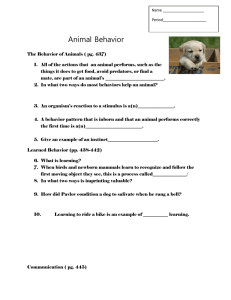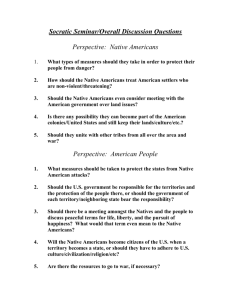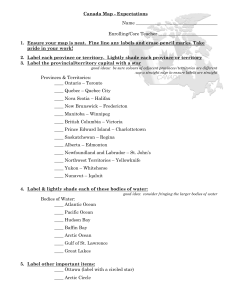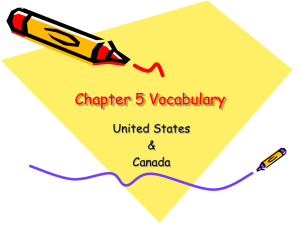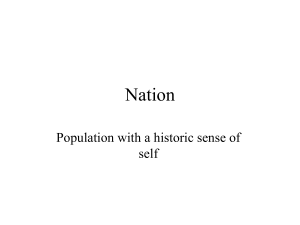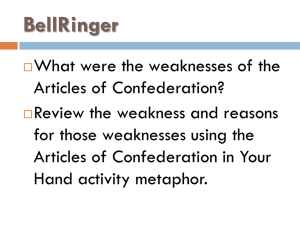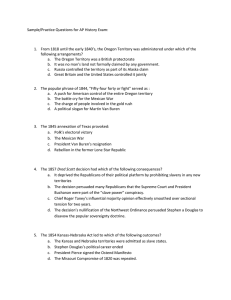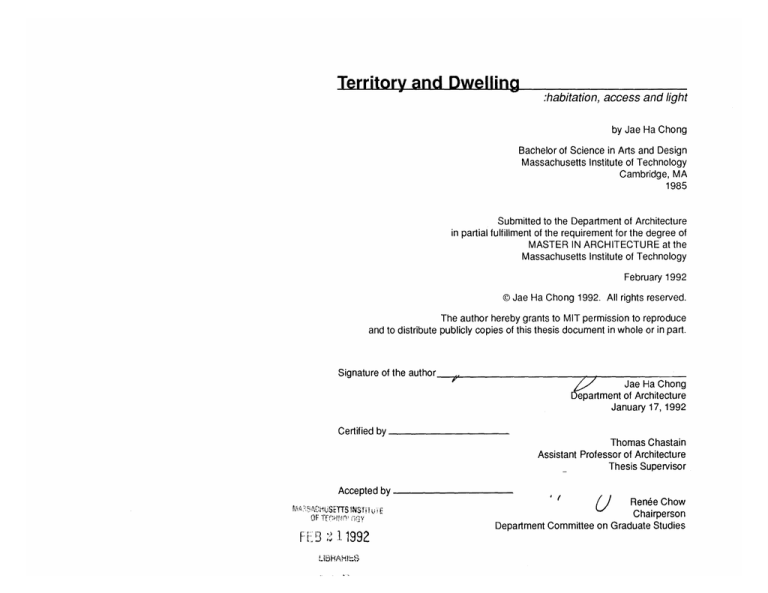
Territory and Dwelling
:habitation, access and light
by Jae Ha Chong
Bachelor of Science in Arts and Design
Massachusetts Institute of Technology
Cambridge, MA
1985
Submitted to the Department of Architecture
in partial fulfillment of the requirement for the degree of
MASTER IN ARCHITECTURE at the
Massachusetts Institute of Technology
February 1992
@Jae Ha Chong 1992. All rights reserved.
The author hereby grants to MIT permission to reproduce
and to distribute publicly copies of this thesis document inwhole or in part.
Signature of the author
Jae Ha Chong
Department of Architecture
January 17, 1992
Certified by
Thomas Chastain
Assistant Professor of Architecture
Thesis Supervisor
Accepted by
1 jS 'TTS iN-aT 0
OF T n1v9
FE B 2 19 92
LiBHA -id
Ren6e Chow
Chairperson
Department Committee on Graduate Studies
Territory and Dwelling
:habitation, access and light
by Jae Ha Chong
Submitted to the Department of Architecture on January 17, 1992
in partial fulfillment of the requirements for the Degree of
Master of Architecture.
ABSTRACT
This thesis is an investigation of the relationship of habitation
and spatial structure through the identification of physical,
functional and positional attributes of territory in dwelling and the
application of those properties in design explorations.
The potential for a space to be used as habitation is
dependant on its form and capacity. Form is made apparent
through the physical definitions of the space. Capacity takes into
account sizes required for patterns of habitation and recognizes
differentiated zones as an extension of space that can
accommodate changes in those patterns.
The organization of space for dwelling is given order through
the spatial structure. Spatial rules govern the location of spatial
components within the territory. Inthe same way, external
positional operations affect the relationship of a space to other
spaces in a larger context. Recurring dimensions in aggregation
give coherence to space and makes it recognizable as an order.
Finally, the relationship of light to the spatial form brings it to life.
The territories in dwelling will be examined in two ways. First, it will
be treated as an isolated spatial artifact. Second, it will be viewed
as a part of a larger ordering. Thus the thesis is organized as
follows:
A. as habitation of space in a dwelling which includes...
1. territory - defined as a place by capacity and by internal
positional attributes
2. access - defined as a space associated with the
territory
B. as a structure or order of spatial form...
1. external positional attributes (extensions of physical
definitions and displacement operations)
2. aggregations of sizes
3. relationship of light
The architectural projects used as reference in this thesis
are Horatio West Court Apartments by Irving Gill, the Sachs
Apartments by Rudolph Schindler and the Rosenbaum Residence
by Frank Lloyd Wright.
Thesis Supervisor: Thomas Chastain
Title: Assistant Professor of Architecture
Acknowledgements
Thanks to my advisor, Thomas Chastain whose endless dedication
and relentless commitment to the pursuit of knowledge guides and
pushes me through this experience and beyond. If I caught only a
little of what you offer, I am well ahead of the game.
Thanks to my reader, Renee Chow, whose patience and wisdom
first focused my attention to architecture and whose methodical
approach brings me to many questions and perhaps some
answers.
Thanks to my reader, Frank Miller, whose insights over the years
keeps me expanding.
Thanks to Phoenix and Tiggs who kept tearing up my work and
rightly so.
Special thanks to Rebecca, whose encouragement , patience and
love gave me the courage to continue.
Thanks to all the people at school and at work whose knowledge
and kindness has made my journey quite an experience.
Thanks especially to my parents whose love, guidance and support
can never be truly repaid.
iv
Contents
T itle Pag e ......................................................................
.. ...-----
Abstract .......................................................................-Acknow ledge ments ......................................................................
iii
Conte nts .......................................................................................
v
Introd uctio n ............................................................................
. .. 1
Section 1: References.................................................................
Horatio West Court Apartments
Sachs Apartments
Rosenbaum Residence
3
Section 2: Habitation of Space .................................................
Physical Definitions
Access and Habitable Zone in Territory
Capacity in Territory
29
Section 3: An Order of Spatial Form ..........................................
External Positional Operations
Aggregations of Sizes
Light and Movement
63
Bibliography ........................................................
Appendix: Design Explorations ...................................................
.. 121
123
vi
Introduction
This thesis has it beginnings in the conviction that housing is
headed towards a prefabricated process. Inthis notion there is a
concern that the housing will be determined by manufacturing
constraints rather than by ergonometric and social pressures.
As I do not have expertise in the manufacturing realm
necessary to examine the problem directly, I have directed my
studies towards an understanding of the design side. This is the
hope that there is the potential to assert the user's interests into the
building process.
The physical requirements of dwelling or living in a space
are often imbedded in the artifacts of habitation. Inother words, the
dwelling is built around the activities of the inhabitants. There are
sizes and dimensions, organizations of space and choice of
materials which facilitate the expression of these activities.
As the occupants of an environment lay claim to the space,
there is an identity which emerges. We see this phenomenon in
vernacular architecture. We identify these spaces as having
"character". The "character" is built by factors such as the
deployment and application of available materials and furnishings,
the knowledge base from which the buildings are constructed and
furnished, and the use patterns which suggest the relationships
between space and material. Coherence and variation exist
simultaneously.
Inthis thesis, the territory is used as a vehicle for examining
the spaces, their positioning and organization from the point of view
of habitation. Territory will be defined as a region in space,
recognizable by physical definitions, use or positional relationships
When viewing a spatial construction as a structuring of territories
through the application of positional operations, the resulting
spaces engage three concepts (habitation, access and light) of
dwelling. These concepts facilitate the production of design by
identifying sizes and relationships of space.
REFERENCES
Graphic Acknowledgements
Horatio West Court Apartments. 1919 - 1922
140 Hollister Street, Santa Monica, CA
Irving Gill
Underlay drawings and illustrations were taken
from drawings prepared by the Office of
Archeology and Historic Preservation incooperation with the University of Southern
California.
Sachs Apartments
Santa Monica, CA
Rudolph Schindler
Underlay drawings and sketches were taken
from "The Form of Neighborly Cluster"
by Shun Kanda, MIT Press, Cambridge, MA
Rosenbaum Residence 1939
Florence, Alabama
Frank Lloyd Wright
Underlay drawings and photographs are from
"Frank Lloyd Wright's Usonian Houses" by
John Sergeant, Watson - Guptill Publications,
New York, 1976
4
Horatio West Court Apartments - Irving Gill
Of7
____
.........
*
................
0
Sn
~II~I ~
.1
01
.1
S
S
*
*
*
*
*
*
*
S
*
S
S
S
S
5
S
S
5
5
S
unit 1
.........
i.
site plan of apartment complex
northeast elevation of court - units 1 & 2
00
*
0
0 00
00
00
0
0
0
northwest elevation - apartment complex
*
0
*
!
0
southwest elevation - apartment complex
vi
first floor plan - unit 1
8
second floor plan - unit 1
9
DLL]D
B-northeast elevation - unit 1
northwest elevation - unit 1
F,
southwest elevation - unit 1
southeast elevation - unit 1
12
CL
0
CD
0
C,
2)
CD)
Sketches
rwv
-I
L
-----
L
unit a
a
unit
site plan
unit b
unitb
unit b
elevation from bottom of apartment complex
section of site through building of unit b
floor plan, unit a
18
a'
floor plan, unit b
19
20
Rosenbaum Residence . Frank Lloyd Wright
living room looking towards entry
living room looking towards dining area
west corner of building
22
patio, south corner of building
4.
-
........ .
J~T*..,.
-
tt -~~~-
-
--
-
---
-
\/b
~-T4,
2
ww.v.v.
.....
.
-4-
--
24
----- -.
oor lan
7*z
I
EKIM
section through living room
IF
IF.
southwest elevation
25
III~I.
L
HEEE~EEIILKEI~
I1. -".
I II
_______
[11
__I.E
section through bedrooms
HH
EB
i i
HE
HU
HE
EB
i i
HE
il
Ki
El
IE
------ -- --------
northeast elevation
26
--
-------i-I--------
------ - ------I
I
M
northwest elevation
----------
southeast elevation
27
28
HABITATION OF SPACE
29
30
Physical definitions
A physical definition is a manifestation of the spatial
structure which suggests the form of the territory and partially
defines the zones within the territory.
A physical definition can be (see diagrams at left) ...
A - a demarcation of real materials which indicate the
extent of the territory.
B - a virtual demarcation of the territory implied by
boundaries drawn between points of materials (typically
perpendicular to nearby surfaces)
C - extensions of planes parallel to surfaces.
-tC
cH
Physical definitions describe qualities about the territory.
Materials describe the surface and articulation of the
territory. The degree of closure, for example, talks about privacy or
separation. The repetition of columns talks about the continuity of
the territory and implies movement through space.
Dimensions which locate the physical elements also impact
the description of territory and its capacity. Coherence in
dimension affects the understanding of the dwelling as an
environment.
Light can modify the qualities of the form and change the
appearance of the physical definitions.
The following study will look at the references and identify
the territory as a distinct space for specific activities of habitation.
Horatio West - Irving Gill
First Floor
Unit 1
-
Living Area
Kitchen
-
Dining
-
Outdoor Living Area
-
Living Area
Bathroom
-
Entry
-
Living Area
-
G
H
J
E
---
-
---
---
'
-1
7.iZ
H.9H
2.
j6r ....
06
2.5
1.
2.45'
2r{
4.59 _
5.87'-.
L6
ClL
G
Horatio West - Irving Gill
Unit 1 - 2nd Floor
A B C -
Bathroom
Bedroom
Bedroom
Ik
9.7 1.5
H~'~1
.5
ee
9.60'
Al-
Sachs Apartments - R.M. Schindler
Unit A
A - Entry
B -
Living Area
C D -
Bathroom
Kitchen
E -
Outdoor Living Area
F
-
Bedroom
-T-
it-
-x-
k,
,I
I
Z*9 .--
k , L,'
.9*V
.9*V
ZZLI
Xtl
,*6
-.. Ie
.t 6
1
.'
l-.
co)
LL
Sachs Apartments - R.M. Schindler
Fn2.'W'Q {#w
Unit B
-
377.
.....
..
*11
I
0I
Dr
-
r..
r
I-
F
G
A-
u
C
38
E
T
A -
Living Room
B -
Entry
C -
Bedroom
D E -
Bathroom
Bedroom
F -
Dining Room
G -
Kitchen
H -
Outdoor Living
15.0'
-x-
.-
it
25
-
...
ii.
...
...
..
.... ..... ......
;.
...
.
B
.
Alow-w
.......
......
7.4'
IL
22.3' *.4.3
If
F
G
3
39
Rosenbaum Residence - F.L. Wright
.......
Nip
.D
*
.
:
* ~
........................
~.ui
~
.............--.-.........-....-.-...-....-.-...-.
4--.--.-*
4
A
B
-
Outdoor Living Area
Entry
C
-
Living Area
D
E
F
G
H
I
J
-
Kitchen
Dining
Bedroom
Bedroom
Bathroom
Bedroom
Study
K
-
Bathroom
20.00'
2.56L
f.0'
10.00'
rI
C
0)
--
..
.....-;
..
03
(D~~~~~~ ..
.L
......
~.
j...
6)
LOA
.
Cl::,e
C
: M
eD
-
12.4'
2.5'
6.6'
i_
F
G
10.0
.01 5.5'
43
44
Access and Habitable Zone in Territory
-h
OW
-o
-~
-
-mn
Territory is differentiated into two general
components: access and habitable zones. The physical
definitions and organization of the territories gives us
dimensions, configuration and location of these components.
Access is a space associated with the territory that
provides a way of moving into and through the space. It
gives information about the internal organization of the
territory as well as linking one territory with other territories.
Finally, access organizes a larger territory.
Habitable zones are spaces in a territory that
accommodate dwelling activities such as sleeping or food
preparation. Inturn, the dwelling activities give identity and
meaning to the physical definitions and characteristics of the
territory.
The physical position of access relative to the territory
can be described in two ways. First, it can be located within
the territory, helping to define and locate habitable zones of
the territory. Second, it can be located at the edge of the
territory, helping to define the edges of the territory.
The continuity of access and the territory can be
either direct of indirect, thus making a claim about the
territory's quality of privacy or publicness.
45
Capacity inTerritory
The capacity of a territory is the potential for that territory to
be an environment for a variety of activities. In a generative sense,
capacity also refers to the territory's potential to evoke those
activities and patterns of inhabitation.
When addressing the capacity of a territory, we ask directly
about the possible activities which can be accommodated by that
territory. Indirectly, we are asking about the territory's dimensions
and internal organization.
The dimensions and internal organization implied or
generated directly from the physical definitions directly affect the
habitation of the space. In'Variations: the Systematic Design of
Supports', John Habraken alludes to the mechanics of capacity.
He postulates use zones ordered parallel to the street in a row
house situation. The use zones can be occupied by a range of
distinct activity spaces He introduces the notion of a margin zone
which is located between the use zones.
The margin zone is of interest because it is a flexible space
which can accommodate extension of the use zone and its
dwelling, access or service functions.
V
"Environmental form is an object that
invites performance and behavior of
people whereas the machine is an
object that performs and behaves."
John Habraken, "The Appearance of
Form"
use zone
V V
SEBV V
a/
margin zone
a use zone
The occupation of the margin and the affect on the adjacent use zones
46
AAAAAAA
.yAA
bed positioned
away from door
L
zone
-swing
door swing &
access dimensions
ftf.eI
The choices made regarding the occupation of the
margins greatly affect the capacity of the adjacent use zones
(see diagram on the previous page). Certain-choices will
disallow other choices. For example, the placement of a
closet in the bedroom will constrain the location of the
furnishings.
Thus, for a specific function, there are positional
attributes associated with the function which affect the
location of other functions relative to it. The drawings on the
left show the positional attributes of a closet and their affect
on the placement of a bed.
Another attribute of position which affects the capacity
of a space is the degree of permeability between the territory
and the building access. The access can be either excluded
or included by the territory. If we say that the access is
included by the territory, we mean that the function or
functions of habitation expressed by the territory can be
extended into the space of the access thus enlarging the
range of potential activities.
The following studies examine the territories identified
in the preceding chapter and groups them by dwelling
function. The study is looking at configuration of access and
habitable zones in addition to the positional attributes and
sizes that are important to capacity.
47
Characteristics of Territory
The diagrams shown on this page show possible positional
relationship and degree of continuity of access to the territory.
The types of territory shown on the next page are derived
from the studies of the references. The drawings suggest possible
configurations of access and habitable zones in relationship to the
territory.
Assuming that the size of access is smaller than the size of
the territory, the access can be positioned either at the edge of a
territory or somewhere within. Inthe simple case, there is one
access to a territory. The two possibilities are depicted in the top
row.
The two lower rows of the taxonomic matrix are members of
the second order of access/territory organizations which share
positional attributes of one or both members of the first order.
Enantiomorphic resultants have been excluded as there is no claim
to scale in the chart.
The access zone refers to the space manifested by the
physical definitions of the territory. While it is not necessary that
the access passes through the territory, access must lead into the
territory.
The habitable zone implies that the dimensions appropriate
to the pattern of occupation are present in the space. For example,
if the territory in question is a bedroom, the minimum dimension for
the habitable zone would include space for the size of the bed and
ancillary spaces.
reinforcement and inclusion of access
reinforcement and exclusion of access
termina
and
inclus
of
acces
termination and exclusion of access
habitable zone (h.z.)
habitable zone (h.z.)
habitable zone
access
access (acc.)
habitable zone (h.z.)
EDGE ACCESS
h.z.
----------
-
-
-..
-.
--...
COMPOSITE
MID ACCESS
h.z.
h.z.
acc.
h.z.
-
habitable zone
-.
acc.
h.z. acc.
(
_
h.z.
acc.
h.z.
acc.
----- 2~
h.z. acc. h.z.
-i--------4-
h.z.
acc.
h.z.
acc.
h.z.
h.z. acc. h.z.
acc.
acc-
h.z.
hIz
h.z.
acc.
-1
1
h.z.
Outside Living Area
2.9'
-e
'.
9.3'
K. . . . . . ....
-
kW'W4~e'w'~dV
Sachs Apartments, unit A
Sachs Apartments, unit B
II
I'
-
1.9'2.5' 2.6'
-1-
r- r
4
r
Horatio West, unit 1
Horatio West, unit 1
Kr, itl±
r'.
0)
<11
..
:
11.6'
21.9'
2.2'i
LD f
LD
V.-......
..
.-
'W
-----------
--- ----------
..
.......
. . .. . . .
Rosenbaum ResidE nce
..........
....
. . . . .....
7
:I
Entry Area
5.5'
4.6'
-------CD
~.LLLL
-4.
I~
T
7
...........
Sachs Apartments, unit A
2.1 l2..3
0
c~J
I I
Horatio West, unit 1
Sachs Apartments, unit B
Rosenbaum Residence
Indoor Living Area
II
Sachs Apartments, unit B
a
........
ri--"
~
I
I
I
I
Sachs Apartments, unit A
1I
3.5.
c~j
(\j_
-
0
'I
Mh
Horatio West, unit 1
- --..v
-
w :
--
a:-u-
.
. .........
............
X.
YI
-
x.
- .
-
- -
.w-m-
-
-
.
-aw -
.
Rosenbaum Residence
Horatio West, unit 1
II
55
Kitchen
2.5' 3.0' 1.9'
c,
r-
I
Sachs Apartments, unit A
-
~
7.3'
..... ........
. . . . . .
.
....
. . . .
. . . . . .
. . . . . .
*d
r~
I
r
r
I I
I
-
4
Sachs Apartments, unit B
I
179
..1 ....
.. . . . . . .
.........
.. . . . . . .
.
. . . . . . ..
. . . . . . ..
i
w
M
i
I
.
....-..
Horatio
Westunit"1MRosenaum"R.sidenc
Horatio West, unit 1
Rosenbaum Residence
L--j
Dining Area
2.5'
3'6-
5. 9'
9.6'
... -.
I
-
4
...
V>___..
~7L~
.
p
-..
..
w...
-+--- -
.-
:K
4 ~~
w'
Ii
I
I. I
~V4V~d
I I
Horatio West, unit 1
i1 !
Sachs Apartments, unit B
I
1
I
I
I
I
Rosenbaum Residence
57
-
Bedrooms
I~
4-
Horatio West, unit 1
6.7'
4-
Horatio West, unit 1
L... .
3.O0
;L
00
-
I-
I
I
I
................
..........
Sachs Apartments, unitB
58
Sachs Apartments, unit A L--a
I
Sachs Apartments, unit B
6.5'
3.4'4. 2
~~I22V
. . .. . .
.
. . . . ....
..
...
..
..
..
Rosenbaum Residence
4
Rosenbaum Residence
i
j.
-
_____
..
w...........
.
.... .
Rosenbaum Residence
II
Rosenbaum Residence
59ri
I
Bathrooms
-2.6'
6.5
Sachs Apartments, unit B
..A.. . .. . .. .
4.-........
Sachs Apartments, unit A
L--4
2 0 2.5'
Cr
-A
---. . . . ...
...
......
Q...
.... ..
Horatio West, unit 1
Horatio West, unit 1
.:
Rosenbaum Residence
60
3
..........
........
Rosenbaum Residence
.
61
62
AN ORDER OF SPATIAL FORM
63
64
External positional operations
Up to this point, we have discussed the territory as a simple
structure which roughly corresponds to the habitable zone, access
and the margins. This section will look at the operations by which
territories interact.
In the references, it was observed that the organization of
territories was governed by several positional rules. If we
reexamine the original definition for territory, we find that we can
extend this definition to include territories which are comprised of
an organization of smaller territories.
For the sake of differentiating the rules imbedded in the
organization of the larger territory from the internal positional
attributes of the smaller territories, we will call these rules out as
external positional operations.
External refers to the organization of smaller territories
implied but not manifested at the size of the smaller territories.
Position refers to the geometric relationship between the different
orders of territories. Operation refers to the arrangement rules
applied to the territories in order to locate them.
The following study will treat the access as being part of the
organization of the building. The territories are shown in
relationship to the building access.
65
Before discussing the positioning of territories, there should
be an inclusion regarding the quality of the relationship between the
territory and the larger access as it relates to this topic.
The external access can be related to a territory in one of
three ways. It can pass through the territory, transforming the
character of the territory to that of being public or readily accessible
to the building organization. The access can pass by the side of
the territory, being reinforced by the definitions of the territory. In
the last possibility, the territory can serve as the termination for the
access.
Having talked about the relationship between the territory
and the building access, we will enter into a discussion about the
positioning of the territories to each other. The simplest case of
multiple territorial interaction begins with two territories. The chart
shown on the next page describes several possible configurations
and the positional operation from which those cases derive.
The chart should be read as a taxonomic matrix with each
drawing being a result of the two operations called at the top and
the left of the chart. For example, the middle drawing would be
classified as an overlapping lateral displacement of the two
territories.
66
Extended Territories and Three Positional Operations
separation
overlap
adjacent
I ........ I -I ........
................
........
........
................
........
........
................
........
. . . . ..- - - -- -- - - ........
................
................
.................................
................
................
.................................
..........
*
***''*
...............
.................................
................
................
.................................
................
................
.................................
................
................
.................................
................
................
....**........
.. ..
...........
...
................
................
................
................
...........
..........
................
.............
...........
.
..
..
..
.
..
...
................
................
................
................
................
................
*.....................
..........
--
I . .I
.
....I
.....
_
_
... .. .. .. ..
I
I
.I...
.-......
-
-
I
-II
I
1..---------------
------
I
axial displacement
1----f ~LII
......
..
.
..
. ..
i I
i
I
I
I
I
I....
I
I
I
I
I
H---
. .-
I-
....
_
-
-
-
.......
..
...
....
..
...
.
...
.
..
...
...
....
...
...
...
....
..
.
.....
....
...
....
...
....
..
...
.
...
..
....
......
...
....
..
...
...
.
...
....
....
...
..
...
....
...
..
...
.
...
....
...
..
....
.
...
...
..
...
...
.....
...
....
....
...
..
...
...
..
...
. .
..
...
.....
...
...
.....
.......
....
....
...
......
......
....
... -.-.. e...e-.--
L..
*-* ..
%-,:.. ..
-1 ..
.=.. ..
*- . .
L;......
...
...
...
....
....
...
...
..
...
.....
...
...
....
...
..
..
..
.......
. . . . .. . . .
...
...
..
....
......
.. . .. . .
I
I
I
-T ------- T -------
lateral displacement
..........
.. ............
.. .............
................
..
.
..
..
..
..
....
....
..
..
..
.
....
................
.................
............
. ............
................
.............
.................
....
................ ......
...............
................
.
................ . .............
................
.
. ............
................
*
.............
***"
..........
............
.
................
................
............
................ . .. ............
I
I
-- I
. .I
.
.- .- -
I
I
I
...I
I
rotation
I
I
I
I
-.
The Territories Positioned
As a case study, the Rosenbaum residence will serve to
illustrate the observable positional operations.
Three territorial sizes have been identified and shown in
relationship to the building access system. The sizes were chosen
to correspond to the dimensions employed in the building.
Building Size Territory - the largest dimensions are built by the
physical extents of the building
Collective Size Territory -the intermediate sizes are derived from
the living room and the collective spaces. The collective size is
consistant with the territories associated with related uses of
habitation.
Private Size Territory - the smallest size is determined by the
dimensions of the private spaces and the adjacent zones which are
related to those spaces.
-K
,.A;'
..........
Access
Building Size Territory
_
.Collective Size Territory
Private Size Territory
69
I
I
~
The Building Size Territory
*1
~
~fiii.
.. . ... . . . . .
B)
The building size corresponds to the
overall dimensions found in the largest
singularly identifiable portions of the
building.
......
.......
..
..................
.................
. ...
. ..
. . ...--..
. . . . . . . . ........
.
The small dimensions are related to the
...........
margin space associated with dwelling
activity. The margin is positioned in
..
relationship to the edge.
The dimension is not as firm number,
but rather, represents a range of
IU..... dimensions
that would accomodate
various activities. We frequently refer to
..........
............
the zone of the margin as "slack".
A Section through Bedrooms
6'
6'
24'
-I1. . .........
A Section through Living Room
-h
-E
Laterally displaced and overlapping
territories
I
I~
I
~
A,
C~/d~.
I I6
I |I
I I
The displacement creates a slack zone
which includes access and light.(A)
The overlapping areas (B)contain most
of the vertical material elements. This
creates a zone from which the
wings of the building extend.
A01_.').'
*
4
I -
One excluded portion terminates the
access. (C)
The other excluded portion defines the
entry zone with an overhang. (D)
iD
Rotated territories
S.....I
II
The intersection of the rotated territories
provides a zone within which the access
turns. (A)
whihlheaces
....
....
........ ...........
mm'7 i
ack..
Collective Size Territory
B
The collective size is roughly made up
of dimensions which correspond to the
living room and the patio.
This size also makes up portions of the
..........- t-.
building which correspond to the entry
zone, the service zone, the sleeping
zone and the study.
36'
6'
A Section through Bedrooms
small building size
-I--f--
6'-
----
--
... ...................
.............................
.........
...............................
.................
. -. - .
.......
. ..............
... J..............
.. ..... .......
.ane
..................
w e sw..
::.
------.-.-.--.--:.: ::.
::::........
I
B Section through Living Area
I
Extension and lateral displacement
I
X.
I
I I
A resulting slack zone accommodates
access and landscape separation. (A)
;M6:
.......
1-11- ..................
............
.............
.
............
. ....................
. .............
...........
. .. . . . . . . . . . . . . . .
CIA09
.........
The other slack zone positions the
kitchen area. (B)
.......
..............
....
........
.......
.........
k
...
.
......
%:.
...
........
.............
........
.......
POW.......
........
........
.......
...........
......
......
...............
...............
......
..........
.... ...... ... .......
....... ......4
.
.
............................
I
I II
Overlap and lateral displacement
provides a zone for movement. (C)
The bedrooms are separated despite
being in line with the main access into
the building.
Overlapping territories
The overlap creates a zone which
the access and light (A)and
Bbbuilds
makes for a transition from inside to
--~
outside.
The lateral displacement creates a
diagonal movement (B)from the living
area to the courtyard, extending the
dwelling from inside to outside.
--
.4 ....
.....
.....
..?.. .. --..
..
. .. . .. .. - --e--- - -
Overlapping territories
&vy~.
.. ......-
The overlap creates a zone which
allows for a change in direction of the
access.
.
.: ;
.
;;;.;..;.;;.;
..
.. .. .t
... .
x..........
~4~7
*......
-4
I
I
lI
I
l
Rotated territories
1--
-FI I
The rotated territory serves as a
termination for the access.
S.y
...
..
.~
'
...
Private Size Territory
The private zones are made up of
-.........
dimensions related to those of the study,
bedrooms, the kitchen, dining area and
the bathrooms.
.
..
.. ..
.
M*~
Fl
II
4'
|
1 6 '1
,
large collective dimension
|
A Section through Bedrooms
sm. collective dim.
-F---------.................
B Section through Living Area
N*
Axial displacements
I
[
..
....
..
.
.
..
... . ... ..
.
The positioning of the private size
territories reinforces the direction of
access. (A) The axial displacement
extends the zones and builds the larger
size.
...%
...........
!rA
The extension of the displacement gives
a zone of separation which allows the
habitation of storage areas. (B)
82
Overlapping and rotated territories
I |
.;~.
..............
.................
.....................
V.
...........
The resulting zones roughly correspond
to the access. The extensions of the
edge access (A)zones partially define a
zone in which the building access turns.
...........
..........
........
..............
*
-7:-7*;
. . .....
....
........
.......
................
.1
RAI
-V.
.........
)6W
.........
0 ......
......
.......
......
...........
..........
Overlapping and rotated territories
I I
|I |
......
I
\
The building access moves between the
territories and turns at the rear edge
zones. (B)
83
Rotated territories
Av
The private size territory is positioned so
as to provide a termination to the
building access.
.rc
-----..................
...................
.....
........
.....
4-W.
............
..........
O.V
/4
........
- ..............
.. ........
. ....................
....
I.........
......
K .
................... .......
POW
e.V ........
%%,VVA.
.....
...
...............
........................
............
...
............
.............
........................
85
Design exploration:
territory and position
The organization for the design
exercise was based on the notion that
the building access provided the basis
for positioning of the smaller territories.
The dwelling activities have a range
of sizes which overlap with the access in
the zone that has been labeled "slack".
Collective areas such as the living
room, dining area and kitchen, are
directly connected with the access and
the physical definitions of the collective
territory are marked by virtual
demarcations and by the arrangement
of the furnishings.
The private territories are marked by
hard edges (walls). The capacity is
implied.
It is possible to realize a range of
other sizes by a building action. The
wall could be moved. The built in closet
can be stripped of the closet furnishings
and used in another way.
The arrows represent possible range
of reconfiguration for furnishings or
materials. The rearrangement implies a
change in the pattern of habitation.
Design exploration:
territory and position
r-.....
...................
..................
first level
I
I
I
Design exploration:
territory and position
I
I
I
slack
second level
I
I
I
I
I
I
Design exploration:
territory and position
I
I
.
!
.
! lElE lD F1IL..
....
_Ruslack
.
L9
third level
I
I
I
I
I
I
89
90
Aggregations of Sizes
we
......
Earlier we alluded to the physical definitions as being part of
a spatial structure. A spatial structure refers to dimensional and
positional rules which organize architecture into coherent works.
In a simple case, we may regard the structural grid as a form
of spatial structure. The building systems are positioned in
relationship to the spatial framework of the grid. There are
dimensions and sizes which are generated from the grid.
One can consider the superposition of territories at all sizes
of a dwelling as a spatial structure.
Inthe following studies of Horatio West and Sachs
Apartments, the spatial structure will be explored as an artifact of
the external positional operations and the disposition of the
territories by identifying a set of sizes for territories and observing
how each size affects and is affected by another.
.*
.-..
. 1......:
. ..
Sizes of Operation
4r
42
.....
r
..
There are a range of sizes for
territories in a dwelling. For detached
units, they operate from the size of the
site down to the sizes of the furnishings.
Each size has a relationship to the
smaller and larger sizes through their
position, use or physical definition.
1.
-
~-±4
the site size
.
".8 .1
W 1;I
I
:. 1'
oWW4 '
I
I
I.
t4,
110
U ~ ~
-*.0
of
4..-
1
~
U-
I
-~c
'it'
the building size
92
!~
the building size to the collective size
'0
0
pp
he private size
WorM
1;
the collective size to the private size
A1
the size of furnishing
Horatio West Court Apartments
......
first...
...
flor.la
The implied shift of the building
territory builds two zones at the edges of
the territory. The two zones correspond
to the outdoor living areas.
94
second floor
first floor plan
A smaller size (A)which includes a
private size and a portion of the building
access is observed. In this case, that
size is one quarter of the area of the
building size.
The dimensions of overlap (B)of two
of these territories give the size of the
entry.
ema
essssigs--mu'
second floor plan
97
. 1-
.._
._ .....-
-
17/
physic I mension
first floor plan
98
C
A smaller size (one sixteenth of the
area of the building size) is positioned at
the edges of the middle size. The
resulting demarcations correspond to
the depth dimensions of access, a
physical extent (the projection of the
hearth) and a slack dimension.
second floor plan
99
.... ... .
.. ... ....
... ...
....
~~........
fi s
100....
ooplan
. ...
..
...
..
::: :.
Ths.rain.sow.te.ep.yen
ofthsedienio.troghutth
dwelling.
.......................................
.........................................................
............... ..........
............................
. .................
....................
%
....................
..................................
...........
...............
.....................
...
.......
..
.
....
....
.
...
............
......
...
..........
.............
.
......
................
....
!.,...........
.........
...
..
..
..
............
..
.............
..................
........
....
......
.....................
....
................
............
. . ..............
. ....................................
.
.............................................................................
......................
............
second floor plan
101
Sachs Apartments, unit B
The study of a Sachs apartment is
an exercise to identify a spatial structure
by examining the physical definitions of
a set of territorial dimension.
I
102
I
I 1
1 4|1
The drawings isolate a private size of
territory which includes a specific
dimension for access. The common
physical definitions are then called out
on the plan.
private size territories and access
I
I
1,
I
2
I
5S
----
I
I
I
A
I
I
----
I
I
13
:-:
I
8
6
I
I
I
I
I
I
1
I
I1
I
91
110
1
103
14
||- 1
|-
Hr
*
Ir
!!Q
-t*-'
7
I-.
--
I 2
-16
These drawings isolate the
previously cited private size of territory
which includes the access within the
extent of the territory.
104
aggregated private size territories
'
*
'
'
'
13
' 14
Ci. ::V%:hk%:i.:..
-C
12
I
I
I
I
I
II
I
I
i i 15
I
I
I
,
I
16
18
105
A
H.Z.
A
I
l
I I
I
I
I
I I
I I
I
H.Z.
H.Z.
I I
IIl
spatial structure diagram
The next four pages identify a
collective size within the dwelling. The
physical definitions of this territory
suggest a third order of access/
habitable zone type. (see diagram
above)
The type is superimposed over
several spaces which share the
demarcations. The access is called out
and the relationship between this spatial
ordering and the access is observed.
106
collective size territories
I
I
--- I
I.I B
19
I
20
.. .. .. ..
I
jilt
'1*
9*
II
II
21
I
1
I
I
22
107
*
.1
:1.
-
I
4.
4
'.3.
-I:
108
.1*
collective size territories
I
I
I
I
N.Jd
ji.<~
~'
-
~W23
I
I
I
I
-24
Irv
J
x.
-
I
I
I
I
I
I
25
109
110
Light and movement
Light is an important component in architecture by its affect
on the quality of a space. In addition to the illumination required to
carry out dwelling functions, light has a great affect on territories.
Light ...
- is introduced to define portions of territories
- articulates the links between territories
. is used to inform the inhabitant of movement
- shows relationships between inside and outside
- reveals spatial form as a dynamic structure by highlighting
elements and by changing in position and intensity through
time
The following studies show light as a generator of movement
and as an operation defining territories.
111
Horatio West Court Apartments
C
C
upper level plan
C
lower level plan
B mmd 6= A
112
The displacement of the territory
builds a zone in which the skylight is
placed. The movement upward is
reinforced by the landing and the wash
of light from the clerestory window
above the turn of the winding stairs.
section A-A
light
The displacement of the next space
(receding and moving up in the diagram)
gives the dimension of the clerestory.
The turn of the stair at the second floor
is also accomodated inthis zone.
The position of the space at the top
of the stairs builds the lateral dimension
of the light well.
-------
-----------------
section A-A
113
The overlap between the stair spaces
and the room territory builds creates a
zone for decision making. The light at
the front of the room extends the room
into this zone.
section A-A
114
This section shows the sequence of
movement up from the opposite side.
section B-B
The zone of overlap gives the
possibility for th e inclusion of light.
section B-B
115
Rosenbaum Residence
Lfi_
a-
.q-d
*-
*
"-
-
. .....
....
... .......-
..... .................
--------------- -floo
116
r pla n
!71
Rosenbaum Residence
section through the Bedrooms
I
-K
I
-1--
.-..-....--.........
. ..
.........
,... ..... . ..
..
. ........
...........
...
::...............
......... :
::
......--..-
-. ---------- ::::::::.::::::::::::: :: ::::.... i
section thrdugh the Living Areh
117
0
cc
C
E
C->
E
C0
00
h.
0*=
a
C
I
j
.4
v~
Design exploration:
light, movement and territory
The drawings shown take the
position that light can be employed as a
territory, exhibit physical attributes and
be subject to the same positional
operations like any other territory.
The territory of light takes its form
from the territories around it and, in
return, affects the adjacent territories.
A * transverse section
key plan
B - interior elevation
119
120
Bibliography
Ching, Francis D.K.
Architecture: Form * Space & Order, Van Nostrand Reinhold
Company, Inc., New York, N.Y., 1979
Ferris, Denise M.
Recognizing Contextual Continuities: Investigations of the
Charleston Single House, MIT Thesis, 1990
Habraken, N.J.
Supports, The Architectural Press, London, 1972
Variations, The Systematic Design of Supports, the Laboratory
of Architecture and Planning at MIT, Cambridge, MA, 1981
Hamdi, Nabeel
Housing without Houses, MIT Press, Cambridge, MA, 1990
Risselada, Max ed.
Raumplan versus Plan Libre, Rizzoli International Publications,
Inc., New York, N.Y., 1988
Rybcynski, Witold.
Home: A Short History of an Idea, Penguin Books, New York,
N.Y., 1987
Sergeant, John
Frank Lloyd Wright's Usonian Houses, Watson - Guptill
Publications, New York, N.Y.,1976
121
122
Appendix: Design Explorations
The following section includes design exercises undertaken
during the course of the thesis term.
The diagram on this page shows sizes generated by the
aggregation of internal organization spatial structures positioned to
extend the building territory into the site.
123
Design exploration:
two-family unit
ground level plan
124
second level plan
125
..
* ...
......... ....
.....
..
section through living area
126
. ...
127
Design exploration:
rowhouse
ground level group
128
.1.
I
V
section through unit
129
==9
...................................
--
KL I44
....................................
I.-
............
Fog
FR
r
-
e1lff,
rrrrrrr
..
...... ............
..
...........
MN.
..........
: .....................................
L
MI
upper bedroom / roof level
131
Design exploration:
position and territory
.........
...
.............
.......
.....
........
....
........................
..........
..........
.............
...
...............
.........
.....
............
.............
......
...
. ................
......
...........
.......................
...........
.........................
.......
.........
...........-.
.
......................
................
....
.....
.
.....
....
...............
..........
collective territory position
-~-
I--7o-7
$
I.Io.
..
..
.................
..
....
.. ......
eritr
private t
132
position--
.
diagram of spatial structure
133
I
~
*
*
..::
...
territories, access and containments
134
I
I
.p
eK~L.
\~~) 4
*
1~"
*
..
*
-*'
U
J-'-*.*-.**'*4
*
5
L.ArctV.
*
*
.
*
.
II
II
.
ii
ground level plan
135
Design exploration:
prototype units in spatial structure
The notion was to examine the
spatial structure as it pertains to a size
larger than the building. A clustered unit
configuration was chosen for this
exercise as it deals directly with the
internal and external organizational
issues.
A "prototype" of unit was developed
using the territorial structure of the
Sachs apartments, and reconfiguring it
in a more compact way.
The "prototype" was then
transformed as it is deployed on the site
in order to accommodate the site
definitions.
136
unit C
4t
unit A
7
2
7
.....
.... .....
unit B
second level plan
137
........ ..... .-.
--... .. . ..... {.
-..--....
unit
13 8...........
A,.ground.floo
......
...
---.".-.-.-.+
......
.-----"..-"----....+........
..............
"
"
-
."
-.-- "...-".."""*""""-
..
"
..-
"
.."
unit A, second floor
139
* -~
unit B, ground floor
140
unit B, second floor
141
unit C, ground floor
142
unit C, second floor
143
144


